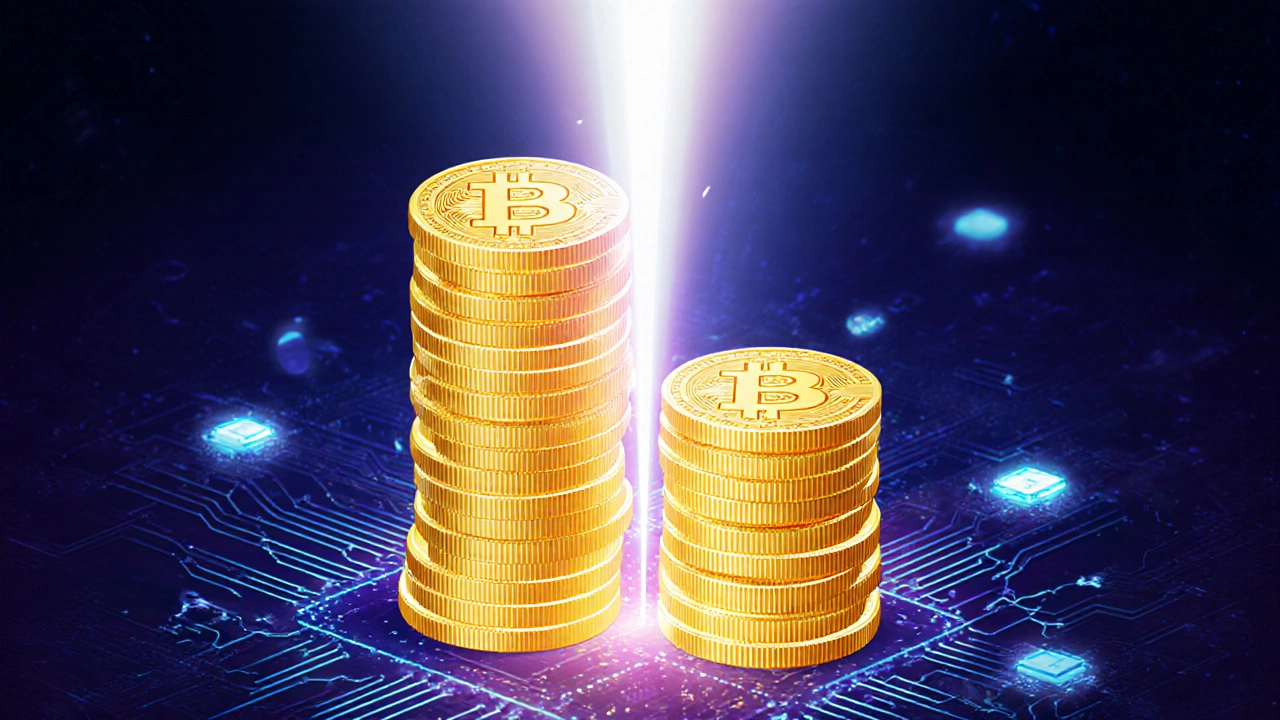When you hear the term Bitcoin block reward is the fresh supply of bitcoins that miners receive for successfully adding a new block to the blockchain, you might picture a simple cash bonus. In reality, the reward is a core driver of Bitcoin’s security, its inflation schedule, and the incentive structure that keeps the network alive. This article unpacks what the block reward actually is, how it’s computed, why it drops roughly every four years, and what that means for miners, investors, and anyone curious about Bitcoin’s monetary policy.
How the Block Reward Is Determined
The reward starts as a fixed number of newly minted bitcoins-currently 6.25BTC per block. That amount isn’t arbitrary; it follows a formula baked into the Bitcoin protocol: the reward equals the “subsidy” set at genesis divided by 2n, where n is the number of halving events that have occurred. Because a new block is found approximately every ten minutes, the network creates about 144 new coins each day, translating to roughly 900BTC per month. The fixed schedule ensures predictability, unlike fiat money that can be printed at will.
The Role of Miners and Proof‑of‑Work
Miners are participants who marshal computing power to solve a cryptographic puzzle. This process, known as Proof‑of‑Work a consensus mechanism that requires work (hash calculations) to validate transactions and secure the network, is energy‑intensive by design. The first miner to find the correct hash publishes the block, receives the block reward, and also collects all transaction fees attached to the transactions inside that block. The reward therefore combines two incentives: fresh coins and the fees paid by users who want their transactions confirmed quickly.
Bitcoin Halving: What Triggers It and Its Impact
A halving an event that cuts the block subsidy in half after every 210,000 blocks, roughly every four years is hard‑coded into the software. When the block height reaches 210,000, the reward drops from 12.5BTC to 6.25BTC; the next halving will bring it down to 3.125BTC, and so on. Halvings are predictable, and markets have historically adjusted to them months in advance. The reduced supply influx puts upward pressure on price if demand stays steady, while also nudging miners toward greater efficiency.

From 50BTC to 6.25BTC: Historical Evolution
Bitcoin launched with a 50BTC reward per block. After the first halving in 2012, it fell to 25BTC, then to 12.5BTC in 2016, and finally to 6.25BTC in 2020. Below is a quick snapshot of how the reward has changed over time:
| Halving # | Block Height | Reward (BTC) | Year |
|---|---|---|---|
| 0 (Genesis) | 0 | 50 | 2009 |
| 1 | 210,000 | 25 | 2012 |
| 2 | 420,000 | 12.5 | 2016 |
| 3 | 630,000 | 6.25 | 2020 |
| 4 (Upcoming) | 840,000 | 3.125 | ~2024 |
This table makes it clear how the reward shrinks predictably, a key factor in Bitcoin’s deflationary design.
How Block Reward Controls Bitcoin’s Inflation Rate
Because the reward schedule is known, Bitcoin’s inflation can be calculated precisely. Early on, with 50BTC per block, the annual inflation rate hovered around 7‑8%. After the 2020 halving, it dropped to roughly 1.8%. By the time the final block (the 6.93millionth) is mined around the year 2140, inflation will be effectively zero, and the total supply will settle at 21million coins-a hard cap enforced by the protocol. This contrasts sharply with fiat currencies that can experience double‑digit inflation in a single year.
Block Reward vs Transaction Fees: Why Both Matter
As the block reward dwindles, transaction fees become the primary income source for miners. Today, fees typically represent 10‑15% of a miner’s revenue, but by 2030 they may account for the majority. This transition is intentional: it ensures that even after all 21million bitcoins are minted, miners will still have a financial reason to secure the network. However, higher fees can raise the cost of using Bitcoin for small transactions, pushing users toward layer‑2 solutions like the Lightning Network.

Future Outlook: What Happens After 2140?
Once the block reward reaches zero, the network will rely entirely on fees. Some experts argue that this could lead to higher transaction costs, while others point to the maturity of second‑layer protocols that keep on‑chain fees minimal. The protocol also contains a built‑in difficulty adjustment, so even if miners earn less from block rewards, the network will still self‑regulate to maintain the ten‑minute block interval.
Quick Checklist for New Miners
- Understand the current block reward (6.25BTC) and upcoming halving schedule.
- Calculate expected revenue: block reward + estimated transaction fees.
- Choose energy‑efficient hardware; efficiency directly impacts profitability.
- Stay informed about network difficulty trends; they rise as more hash power joins.
- Plan for the long term-revenues will shift from subsidies to fees over the next decade.
Frequently Asked Questions
What exactly is a Bitcoin block reward?
It is the amount of newly created bitcoins that a miner receives for adding a verified block to the blockchain. The reward is programmed to halve every 210,000 blocks.
Why does the block reward halve?
Halving controls the issuance rate, ensuring the total supply never exceeds 21million BTC. It also creates a predictable, decreasing inflation schedule.
How many halvings will Bitcoin experience?
Approximately 33 halvings are expected before the block reward reaches zero around the year 2140.
Will miners stop after the reward disappears?
No. Miners will continue earning transaction fees, which are expected to become the dominant revenue source once the subsidy ends.
How does the block reward affect Bitcoin’s price?
A lower supply influx can create upward price pressure if demand remains steady. Historically, markets have priced in halvings months before they occur.

